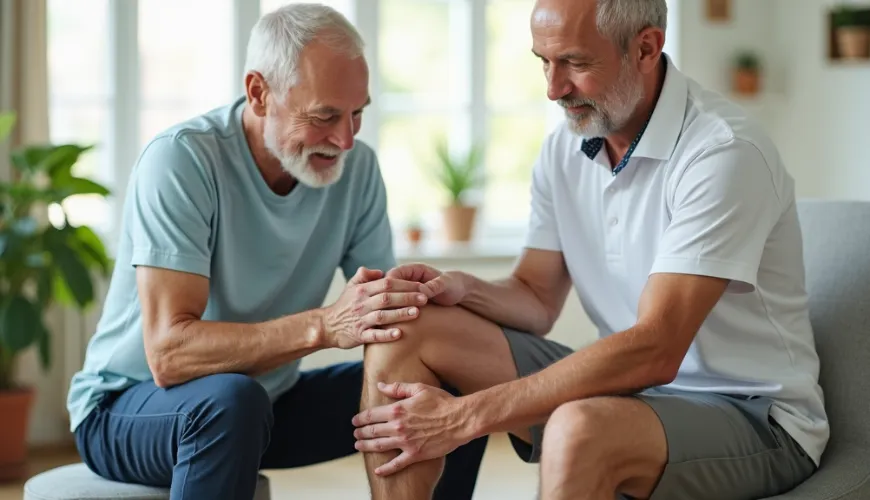
Reasons Why You Might Experience Pain in the Popliteal Fossa

When It Hurts Behind the Knee - What Can Pain in the Popliteal Fossa Mean?
Pain in the popliteal fossa is one of those symptoms that can really unsettle a person. And it's no wonder — the knee is one of the most heavily burdened joints in the body, and any pain around it can signal a wide range of issues. From overuse to muscle tension to more serious conditions like thrombosis. Because of this variety of causes, it's important not to neglect even seemingly minor discomfort in the back of the knee.
Why Does Pain Occur in the Popliteal Fossa?
The popliteal fossa, the area at the back of the knee joint, is a complex knot of tendons, muscles, blood vessels, and nerves. In this small but crucial area, various types of pain can occur depending on which part is affected.
The most common causes include:
- stretching or tearing of muscles and tendons,
- tendonitis (inflammation of the tendons),
- Baker's cyst (a cyst originating from the knee joint),
- meniscus injury,
- deep vein thrombosis (DVT),
- osteoarthritis or rheumatic disease,
- nerve compression.
The key distinguishing factor is the nature of the pain — whether it occurs only when walking, at rest, or is constant and worsens with movement. For example, pain in the popliteal fossa when walking can signal a mechanical issue, while severe pain in the popliteal fossa at rest can be a warning sign of more serious vascular problems.
When Pain in the Popliteal Fossa Signals Thrombosis
One of the most serious possibilities to consider is deep vein thrombosis. In this case, a blood clot forms in the deep veins, most often in the lower limbs. If the blood clot dislodges and travels to the lungs, it can cause life-threatening pulmonary embolism.
How to recognize that it might be thrombosis? Typical symptoms include:
- severe, sudden-onset pain in the popliteal fossa or calf, which may spread higher or lower,
- leg swelling, often asymmetrical (only on one side),
- redness or bluish discoloration of the skin,
- a feeling of warmth in the area of pain.
Thrombosis does not always manifest dramatically. In some cases, pain in the popliteal fossa at rest is the only symptom. It is therefore important to pay attention to any atypical changes and, in case of suspicion, seek medical attention immediately. Timely diagnosis can indeed save a life.
What If the Knee Hurts Only When Walking?
If the pain occurs exclusively during movement, especially when walking up stairs, squatting, or playing sports, it is most often due to muscle or tendon overload. In such cases, the body is asking for rest. However, sometimes the pain is caused by a Baker's cyst, which occurs when synovial fluid accumulates in the back of the knee.
A typical symptom of a cyst is pressure or pain in the popliteal fossa when walking, or a feeling of a "full knee." The cyst can press on surrounding nerves and blood vessels, increasing pain and potentially limiting movement. If the cyst enlarges or ruptures, it can cause swelling and increased temperature in the entire limb — symptoms that mimic thrombosis. In these cases, medical examination, often including an ultrasound, is again advisable.
When Knee Pain Persists Even at Rest
Pain that persists even in a resting state — for example, in the evening while resting or during sleep — can be a sign of chronic inflammation or rheumatic disease. Especially in the older population, osteoarthritis also appears, initially causing only mild problems but in later stages can cause severe pain in the popliteal fossa at rest, swelling, and joint stiffness.
On the other hand, in young athletes or active people, persistent pain may indicate microtraumas caused by prolonged overuse. An example is the case of Mrs. Jana, a 35-year-old graphic designer who took up daily running during the pandemic. After a few weeks, she began to feel pressure in the back of her knee, which turned into sharp pain. It turned out to be inflammation in the area of the hamstring attachments, which required several weeks of rest and physical therapy. "At first, I thought it would just go away. But when my knee hurt even at night, I realized it wasn't just fatigue," she recalls.
When to See a Doctor?
Occasional mild pain in the popliteal fossa is not always a cause for panic. However, if the pain persists, worsens, or is accompanied by other symptoms such as swelling, skin discoloration, or fever, it's worth not delaying.
If you experience leg problems, it's important to be alert and definitely contact a doctor in some specific situations. For example, when you're surprised by sharp, sudden, or very severe pain that doesn't improve and rather intensifies, whether when walking or even when just sitting or lying down. Similarly, you should be alert if the pain limits movement so much that you can barely take a step.
Also, pay attention to physical changes – if the leg or another limb is noticeably swollen, reddened, or warm to the touch, it may not just be a strained muscle. Particularly suspicious is if the swelling is only on one leg – this may indicate something more serious, like a vascular problem. And if someone in your family has dealt with thrombosis, or you've experienced it yourself, then it's not wise to dismiss such symptoms. In these cases, it's most prudent not to delay and seek professional help, as a timely response can prevent really serious complications.
A doctor will usually perform a clinical examination and, if necessary, recommend an ultrasound, X-ray, or blood tests. In case of suspected thrombosis, immediate diagnosis and possibly anticoagulant treatment are necessary.
What Helps with Pain in the Popliteal Fossa?
Treatment varies depending on the cause. While rest, icing, and stretching primarily help with overuse or minor muscle strains, more serious cases require professional care. Physical therapy, compensatory exercises, or even changing footwear or movement ergonomics can have a significant impact on improving the condition.
In some cases, such as with a Baker's cyst, aspiration or injection therapy may help. If the pain is caused by osteoarthritis, maintaining a healthy weight, regular exercise without overloading the joints (e.g., swimming or cycling), and appropriate nutrition for joint cartilage are recommended.
A lifestyle change can also help. Adequate physical activity, a healthy diet rich in omega-3 fatty acids, hydration, and stress reduction — all these factors affect not only vascular health but also the overall condition of the musculoskeletal system. As renowned Czech physiotherapist Pavel Kolář says: "The body remembers not only movement but also immobility."
Try our natural products
Whether it's dull pain while sitting, sharp pain under load, or suspicion of a more serious condition, it's not wise to ignore the body's signals. The popliteal fossa is a small area, but it can be a major indicator that something is not right with our body.





